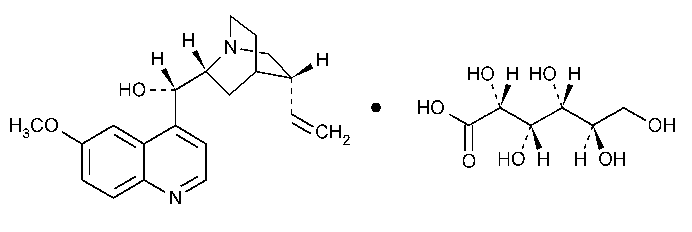Quinidine Gluconate
Cinchonan-9-ol,6¢-methoxy-,(9S)-,mono-D-gluconate (salt)
Quinidine mono-D-gluconate (salt) [7054-25-3].
»Quinidine Gluconate is the gluconate of an alkaloid that may be obtained from various species of Cinchonaand their hybrids,or from Remijia pedunculataFlückiger (Fam.Rubiaceae),or prepared from quinine.Quinidine Gluconate contains not less than 99.0percent and not more than 100.5percent of total alkaloid salt,calculated as C20H24N2O2·C6H12O7,on the dried basis.
Packaging and storage—
Preserve in well-closed,light-resistant containers.Store at 25 ,excursions permitted between 15
,excursions permitted between 15 and 30
and 30 .
.
USP Reference standards á11ñ—
USP Quinidine Gluconate RS.USP Quininone RS.
Identification—
A:
A1in 2000solution in dilute sulfuric acid (1in 350)exhibits a vivid blue fluorescence.On the addition of a few drops of hydrochloric acid,the fluorescence disappears.
B:
In the test for Chromatographic purity,the RFvalue of the principal spot obtained from the Test preparationcorresponds to that from the Standard preparation.
C:
Asolution (1in 50)is dextrorotatory.
D:
Dissolve 700mg in 5mLof water with the aid of heat,and add 1mLof glacial acetic acid and 200mg of phenylhydrazine hydrochloride.Heat in a water bath for 15minutes,cool,and scratch the inner surface of the tube with a glass rod:orange crystals are formed.
Loss on drying á731ñ—
Dry it at 105 for 1hour:it loses not more than 0.5%of its weight.
for 1hour:it loses not more than 0.5%of its weight.
Residue on ignition á281ñ:
not more than 0.15%.
Heavy metals,Method IIá231ñ:
0.001%.
Limit of dihydroquinidine gluconate—
Methanesulfonic acid solution—
Add 35.0mLof methanesulfonic acid to 20.0mLof glacial acetic acid,dilute with water to 500mL,and mix.
Diethylamine solution—
Dissolve 10.0mLof diethylamine in water to obtain 100mLof solution.
Mobile phase—
Prepare a filtered and degassed mixture of water,acetonitrile,Methanesulfonic acid solution,and Diethylamine solution(860:100:20:20).Adjust with Diethylamine solutionto a pHof 2.6.
System suitability solution—
Transfer about 10mg each of quinidine gluconate and dihydroquinidine hydrochloride to a 50-mLvolumetric flask.Dissolve in about 5mLof methanol,dilute with Mobile phaseto volume,and mix.
Test solution—
Transfer about 26mg of Quinidine Gluconate to a 100-mLvolumetric flask,dissolve in and dilute with Mobile phaseto volume,and mix.
Chromatographic system(see Chromatography á621ñ)—
The liquid chromatograph is equipped with a 235-nm detector and a 3.9-mm ×30-cm column that contains packing L1.Chromatograph the System suitability solution,and proceed as directed for Procedure:the relative retention times for quinidine and dihydroquinidine are 1and 1.5,respectively;the resolution,R,between the quinidine and dihydroquinidine is not less than 2.5;and the relative standard deviation for the peak response is not more than 2.0%.
Procedure—
Inject about 50µLof the Test solutioninto the chromatograph,record the chromatogram,and measure the peak responses.The response of the dihydroquinidine peak is not greater than 0.25that of the quinidine peak (20.0%).
Chromatographic purity—
Standard preparation—
Prepare a solution of USP Quinidine Gluconate RSin diluted alcohol to contain 6mg per mL.
Diluted standard preparation—
Dilute a portion of the Standard preparationwith diluted alcohol to a concentration of 0.06mg per mL.
Related substances preparation—
Prepare a solution in diluted alcohol containing in each mL0.04mg of USP Quininone RS(corresponding to 0.06mg of the gluconate),and 0.08mg of cinchonine (corresponding to 0.12mg of the gluconate).
Test preparation—
Prepare a solution of Quinidine Gluconate in diluted alcohol to contain 6mg per mL.
Procedure—
Apply 10-µLportions of the Test preparation,the Standard preparation,the Diluted standard preparation,and the Related substances preparationto a suitable thin-layer chromatographic plate (see Chromatography á621ñ)coated with a 0.25-mm layer of chromatographic silica gel.Allow to dry,and develop the chromatogram in a solvent system consisting of a mixture of chloroform,acetone,and diethylamine (5:4:1),the solvent chamber being used without previous equilibration.When the solvent front has moved about 15cm,remove the plate from the chamber,mark the solvent front,and allow the solvent to evaporate.Spray the chromatogram with glacial acetic acid.Locate the spots on the plate by examination under long-wavelength UVlight.Any spot produced by the Test preparationat the RFvalue of a spot produced by the Related substances preparationis not greater in size or intensity than that corresponding spot.Apart from these spots and from the spots appearing at the RFvalue of Quinidine Gluconate and dihydroquinidine gluconate (the two spots most evident from the Standard preparation),any additional fluorescent spot is not greater in size or intensity than the principal spot of the Diluted standard preparation.Spray the plate with potassium iodoplatinate TS.Any spot produced by the Test preparationis not greater in size or intensity than a corresponding spot from the Related substances preparation.
Organic volatile impurities,Method Iá467ñ:
meets the requirements.
Assay—
Dissolve about 150mg of Quinidine Gluconate,accurately weighed,in 10mLof glacial acetic acid,heating gently if necessary.Cool the solution,add 20mLof acetic anhydride and 4drops of p-naphtholbenzein TS,and titrate with 0.1Nperchloric acid VSfrom a 10-mLmicroburet to a green endpoint.Perform a blank determination,and make any necessary correction.Each mLof 0.1Nperchloric acid is equivalent to 26.03mg of total alkaloid salt,calculated as C20H24N2O2·C6H12O7.
Auxiliary Information—
Staff Liaison:Andrzej Wilk,Ph.D.,Senior Scientific Associate
Expert Committee:(PA5)Pharmaceutical Analysis 5
USP28–NF23Page 1692
Pharmacopeial Forum:Volume No.29(5)Page 1568
Phone Number:1-301-816-8305
